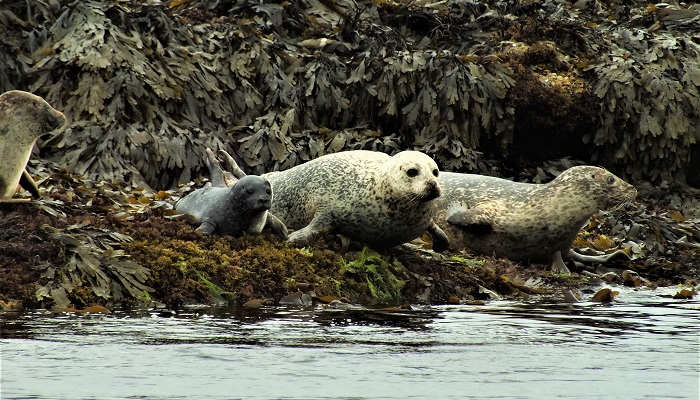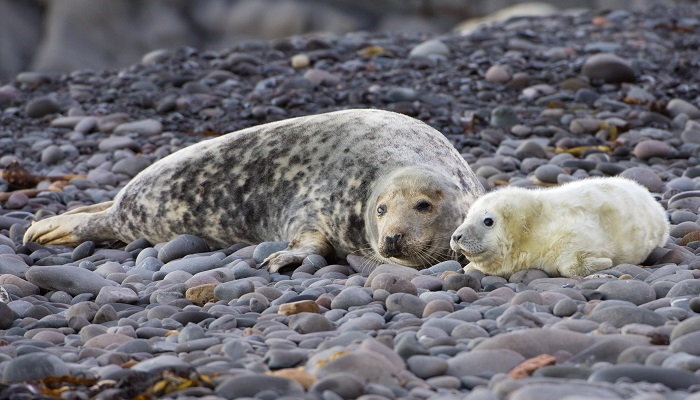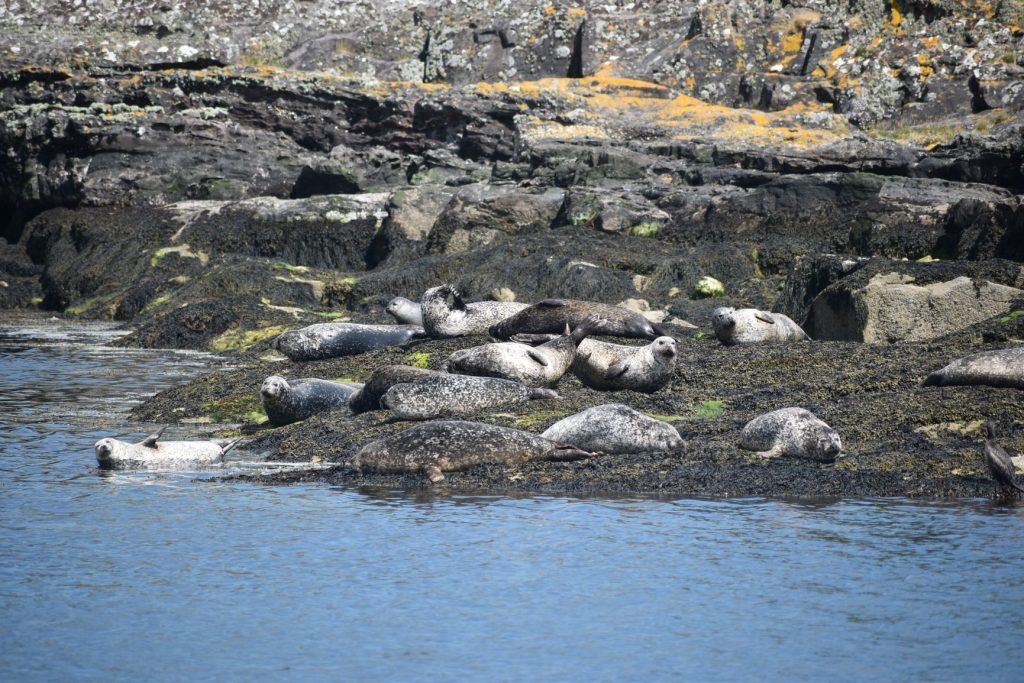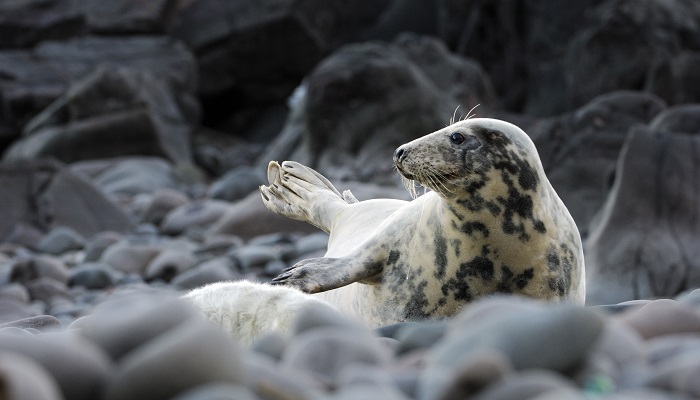Marine
Responsible wildlife watching around seals
September 19, 2023 by Marine Directorate Communications No Comments | Category Collaborations, Marine Directorate general, Marine Directorate Science, Marine Environment, Marine Planning, Marine Renewables
Scotland is well known for our diverse flora and fauna, both on land and in the sea. Some of the most iconic species seen around our coasts are seals. Scotland is home to a population of approximately 121,000 grey seals and 27,000 harbour (common) seals.
Haul out sites are where seals come out of the water to rest, moult, breed, and to have pups. Seals that are hauled out may be particularly sensitive to approach by humans whether from the land, sea or air and therefore caution is required in such circumstances.
Section 117 of the Marine (Scotland) Act 2010 provides Scottish Ministers with the power to designate seal haul out sites. Following work between the Marine Directorate and the Sea Mammal Research Unit (SMRU) at the University of St Andrews a number of sites were identified. A map of all 195 locations can be found here.
Under the Marine (Scotland) Act 2010 it is an offence to intentionally, or recklessly harass a seal at a designated haul out site. The Marine Directorate has produced guidance which includes examples of actions that might constitute harassment and information on behaving responsibly around seal haul outs.
Karen Hall, NatureScot Marine Ecology Advisor comments:
“We all love to watch wildlife, but we also need to protect it. We’re asking people to stay well clear of the seal haul out sites. At this time of year, grey seals are starting to pup, so it’s a sensitive time for this species. Watching from a distance minimises disturbance and can give great views of natural behaviour.”
Seal behaviour
Seals rest on land to conserve energy, or for females to nurse their young. This is also time when the seals can regulate their temperature while they moult, either due to pups growing in their adult fur, or the annual moult of adults. Regulating temperature in water and swimming all expends energy. When forced to enter the water to avoid a perceived threat, seals are stressed and use additional energy. It is also a danger to new pups that may be injured or killed by adults in large groups that rush into the water.
There are some body language cues that can let you know if you are at risk of disturbing seals. They have a three-stage response to perceived threats:
- heads-up – the seals raise their heads and watch your location and approach. If you see this behaviour, you should back away and/or change your method and speed of approach.
- movement – the seals will start to shift around and appear agitated. If they were laying on their sides they may move to their stomachs to allow them to retreat. If you notice this behaviour you need to back off from the seals so you do not cause the third stage of the response.
- stampede – the seals will quickly retreat from land to the water to escape. This puts the seals at risk of injury as well as any pups that are amongst them.
The Scottish Marine Wildlife Watching Code (SMWWC) provides recommendations and advice on responsible wildlife watching. Some helpful tips include:
- look up the site you intend visiting for any local wildlife management information and follow their guidance
- be aware of the local pupping seasons – avoid visiting breeding sites during these periods
- keep your distance and keep dogs away as they can cause a stampede response
- do not try to touch or feed seals, they can move surprisingly fast and as cute as they may appear they are predators and are known to bite
- never separate pups from mothers as this leads to stress for both and risks abandonment by the mother
- leave lone pups alone – the mother may only be foraging for food
- signs that a pup may have been abandoned can be found on the British Divers Marine Life Rescue (BDMLR) website
- don’t crowd or encircle seals and do not stand between them and an escape route to the water
- keep the noise down and avoid sudden movements
Going for a walk on the beach is a great way to get a dose of fresh air and daily exercise. Remember to do so safely for the animals that know those beaches as safe places.
Frequently asked questions
What is a designated seal haul out site?
A designated haul out site is any place, which Scottish Ministers designate as such by Order, after consulting with UK Research and Innovation (UKRI). These are identified as areas of consistent high density (hotspots) for harbour and grey seals.
What are the 195 sites designated for?
Of a total of 149 haul out sites:
- 62 are used mainly by harbour seals
- 20 are used mainly by grey seals
- 67 are shared by both these species
Additional sites are grey seal breeding colonies, used by this species specifically during their pupping season. All of these sites provide protection all year round.
Are there any times of year that are particularly sensitive?
Harbour seals usually give birth in early summer (June – July) and spend time ashore in August for their annual moult.
Grey seals give birth in the autumn (September – December) and stay on land for several weeks. Adults and pups leave in the spring once they have finished their moult and the pups have been weaned.
What constitutes harassment?
Details on intentional and reckless harassment can be found in the Guidance on the offence of harassment at seal haul out sites.
What should I do if a group of seals reacts to me watching them?
This is an early sign that the seals could be scared from their resting place. If you notice either steps one or two detailed above in the seal behaviour section, you should back away and review your approach.
What should I do if I see a seal that doesn’t look healthy?
You can contact Scottish Society for Prevention of Cruelty to Animals (Scottish SPCA) or BDMLR if you are concerned for the welfare of a seal.
What should I do if I suspect someone of committing an offence by harassing seals?
If you are concerned that you have seen someone commit a wildlife offence please contact the Marine Directorate on 0131 244 2286 or via our website. Alternatively you can contact Police Scotland on 101 or using their website.
What about other wildlife?
NatureScot’s guide to best practice for watching marine wildlife provides advice on wildlife watching on land and at sea.
What do I do if I find a dead seal?
If you come across a seal carcass, you should contact the Scottish Marine Animal Stranding Scheme (SMASS) via phone/text 07979 245893 or email reports@strandings.org
When you report a dead stranding, please try to provide the following information:
- date found
- location (grid reference if possible)
- photographs of the carcase
- species or description (see species guide)
- overall length (estimation)
- condition of the animal
- your contact details
Further information
Main picture: harbour seal and pup. Picture provided by Jack Lucas/Crown copyright.
Tags: British Divers Marine Life Rescue, marine wildlife, NatureScot, Scottish Marine Wildlife Watching Code, Scottish SPCA, Sea Mammal Research Unit, Seal behaviour, seal haul out sites, seal strandings, UK Research and Innovation, University of St Andrews






Leave a comment